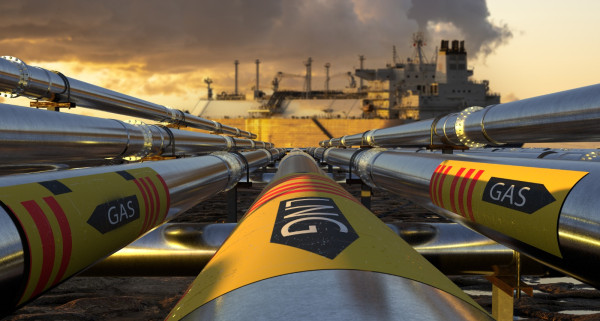From exploration to production and export, the Angolan oil and natural gas industry is bustling with new initiatives. This past year alone, international oil companies and the Angolan government partnered to award numerous regional operators with service contracts worth billions of dollars in combined value.
The African Energy Chamber has been particularly pleased to see Angola driving its natural gas industry forward.
In August 2022, solidified plans to develop the Quiluma and Maboqueiro gas fields in the Lower Congo Basin offshore Angola saw Italian multinational oilfield services company Saipem granted USD900 million between three engineering, procurement, and construction contracts for both onshore and offshore work associated with the project at three separate sites.
Movement on these endeavors is due in part to the establishment of the New Gas Consortium (NGC) and its relationship with Angola’s National Agency for Oil, Gas & Biofuels. Investment in the NGC is multi-national, with Italian hydrocarbon giant ENI at the helm and France’s TotalEnergies, British Petroleum, and Angola’s Cabinda Gulf Oil Company and Sonangol signed on as shareholders. The NGC expects production at the Quiluma and Maboqueiro fields to begin in 2026 and to produce at an estimated rate of 4 billion cubic meters (bcm) of liquefied natural gas (LNG) per year.
The Right Approach
This success story, just one among many in Angola, wouldn’t be possible without the welcoming and investment-friendly environment that Angolan leadership has worked to cultivate in recent years.
Despite its status as sub-Saharan Africa’s second-largest oil producer, boasting an approximate output of 1.55 million barrels of oil per day (bpd), Angola rejects complacency and strives to grow those numbers by starting new wells while reevaluating its more mature facilities. Angola’s approach and its commitment to continued progress should serve as a template for every other African country to follow.
Angola sits atop 27 trillion cubic feet of natural gas — a largely untapped wealth of resources that represents a path toward vast employment opportunities, a route away from energy poverty, and a bridge to an eventual energy transition. One of the key elements ensuring that this economic development evolves in both Angola’s and Africa’s favor is a competent administration to help guide it.
The Right Leader at the Right Time
Since taking office in 2017, President João Lourenço has maintained a positive bearing on strengthening and enhancing Angola’s oil and gas sector and focusing on enriching its population.
Employing a rational, long-term mindset in the effort to expand Angola’s LNG exports and further develop its gas industry, President Lourenço has been managing a multi-faceted master plan that he hopes will set Angola in an exponentially more prosperous position over a 30-year timeframe.
Lourenço’s actions in this regard have been proactive and comprehensive and performed in support of a healthy national oil and gas industry. By working to improve Angola’s business environment and rooting out internal corruption, Lourenço has made the nation much more attractive and favorable to foreign investment. The reappointment of Diamantino Pedro Azevedo as Minister of Mineral Resources — a key player in Angola’s regulatory overhaul and an outspoken advocate for the African energy industry — demonstrates Lourenço’s commitment to preserving a cabinet that produces meaningful results.
President Lourenço’s outlook includes much more than the successful export of Angola’s hydrocarbon resources. His plan includes provisions for expanding the country’s refining and storage facilities as well as preparations for the transition to a low-carbon economy through the implementation of photovoltaic power plants, the production of green hydrogen, and a pledge to increase Angola’s own use of energy from clean sources like hydroelectric.
Lourenço has confidence that his country will be able to achieve these goals in part by fostering productive international relationships, a practice that he contends will also secure future business partnerships.
A Ready-Made Market
President Lourenço’s 2022 Whitehouse meeting with U.S. Secretary of State Antony Blinken and Secretary of Defense Lloyd Austin concluded with Blinken’s declaration of Angola as a strategic partner and the announcement of a €1.8 billion U.S. investment in a system that will supply four provinces in southern Angola with photovoltaic power.
The wide-ranging difficulties extending from the ongoing war in Ukraine have put Europe in a precarious situation concerning its natural gas provisions, the bulk of which came from Russia until the start of the conflict. President Lourenço has confidence that Angola can offer Europe an alternative source of LNG through European investment in the country and cooperative relations between the two regions.
Angola may get to a more sizeable position in the global LNG market, and sooner than expected, even without Europe’s immediate support. Lourenço foresees an economic boom on the horizon that will put Angola’s LNG production and export on the fast track in the coming years.
System-Wide Improvements
In addition to the developments at the Quiluma and Maboqueiro fields, other Angolan natural gas projects are well underway.
The Angola LNG Project, a joint venture led by Chevron and Sonangol north of Luanda in the province of Soyo, processes and monetizes 1.1 billion cubic feet of natural gas per day while reducing gas flaring and greenhouse gas emissions.
Sonangol has also been hard at work in Cabinda, modernizing, automating, and subsequently tripling their plant’s gas filling capabilities from 3,000 12-kilogram gas cylinders per day to 9,000 cylinders per day, which should increase regional gas availability by 28%.
By next year, Angola expects the 750 MW Soyo II combined-cycle power plant to be operational, which will contribute to a nationwide effort to expand the population’s electricity access by nearly 20% via gas-to-power generation.
Angola’s Falcão Natural Gas Project promises to diversify the country’s stake in the natural gas industry by providing a means of producing fertilizer, reducing reliance on importation while cutting overall agricultural costs.
These developments — paired with Minister Diamantino Azevedo’s assurances at the 2022 International Conference on Angola Oil and Gas that Angola will soon have floating liquid natural gas platforms off its shores — paint a positive picture for Angola’s energy future.
“We celebrate Angola’s progress in the LNG sector. Natural gas offers a clean and practical energy source with the power to eradicate energy poverty and boost local economies across the continent while also providing a pathway toward a just energy transition. We encourage all the nations of Africa to join Angola on the trail they are currently blazing”. Stated Sergio Pugliese, President of the African Energy Chamber-Angola.
Distributed by APO Group on behalf of African Energy Chamber.
SOURCE
African Energy Chamber





